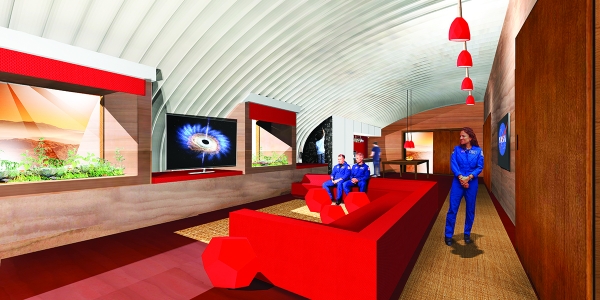
Taking a page from the Smurfs, future astronauts colonizing the surface of Mars could be building their domiciles out of mushrooms.
Specifically, research biologists at NASA Ames are looking to the surprisingly versatile properties of mycelium -- the fibrous, fuzzy-looking strands of fungus that you might find growing in your yogurt if you leave it out for too long.
Mold and countless other fungi all have mycelium, which grow rapidly like plant roots in search of nutrients and reproduction. In recent years, mycologists (that is, fungus researchers), have been touting a range of new products that can be made from mycelium, including packing foam, plastics and building materials similar to particle board.
The fungal products are more than just novelties. In fact, some of the significant advantages of these mycelium-made materials are being demonstrated here on Earth.
Cleveland-based architect Chris Maurer first began experimenting with designing houses that incorporated mycelium-built plywood in their walls. This so-called myco-architecture is fire resistant, and it also can also provide insulation for the home. Taking the idea further, he incorporated mycelium to cleanse wastewater, even letting some grow into mushrooms to provide a ready food source.
Maurer's idea was to use myco-architecture as a sustainable shelter for refugees in Africa, especially in resource-sparse areas affected by climate change.
"What I love about these biomaterials is we can use it in a minimal resource environment," Maurer said. "Mycelium might look light and fluffy, but it can grow at an explosive rate and even go through rock or asphalt."
His work caught the attention of Lynn Rothschild, a NASA Ames researcher who pioneered the field of astrobiology. Rothschild just happened to be finishing up similar work on the advantages of biomaterials. Hearing about Maurer's work, she realized that fungus could be a substantial improvement over the heavy materials that would have to be transported to build habitats on Mars. Both of them are now partnering on the new study.
In basic terms, Rothschild envisions future astronauts being able to essentially grow their building materials as needed on Mars, rather than lugging it from Earth. This would require some rubber bags for the spores to grow in, but these could be stowed in a fraction of the space that it would take to bring girders, beams or other materials from Earth. She anticipates some type of lightweight hollow plastic shell could be brought from Earth, and the mycelium could be used to fill it out its framework, sort of like drywall.
With just a little bit of water and some type of feedstock, the spores could germinate in a couple days and fill out a container. With heat and pressure, these fungal roots can then be compacted into durable materials that could rival most currently available products.
Rothschild points out that packed mycelium boasts a compression strength superior to lumber, and bend strength more robust than reinforced concrete. The material also shows promise to resist fire and small meteorites, and she is hoping it can even be bioengineered with pigments to shield against radiation.
Perhaps the biggest advantage for mycelium is its versatility. based on how it's grown and compacted, mycelium can produce leather-like fabrics or rigid material suitable for structural frames. Rothschild believes the enzymes normally excreted by mycelium could be engineered to produce bioplastics or latex materials. Even better, the products can later be broken down for fertilizer for farming.
"Of all the projects I've done, this is the one that has the clearest path to getting up and going," Rothschild said. "I really don't think this is beyond our technological capabilities."
Granted, there are still plenty of challenges with this concept that will need to be vetted. In particular, mycelium will need an ample supply of organic material to keep it growing. That's a big problem on Mars, where there's no known organic life for now, at least.
A good workaround here is cyanobacteria, Rothschild said. This type of algae can gain nourishment through photosynthesis, just like plants. The algae would be a convenient feedstock, but it also would be useful on Mars for other reasons, including that it produces oxygen and CO2. Even better, this algae can also be eaten by humans.
Rothschild is the first to admit that many questions still remain. With thousands, perhaps millions of fungi species here on Earth, she isn't sure which one would serve best on the red planet. It's also unknown how exactly fungi would grow with Mars' extremely low temperatures, even when insulated.
For NASA, a big worry hanging over this idea is what would happen if fungal spores somehow escaped and contaminated Mars. What if this fungi ended up harming some unknown life on Mars?
"I'm an astrobiologist. If there was life on Mars, it would be one of the greatest tragedies to not be able to study it," she said. "What we're talking about would be double-enclosed, so there's no chance of a spore getting out."
In March, NASA announced Rothschild's "myco-architecture" study would be funded through the agency's Innovative Advanced Concepts program, which is normally reserved for long-term research. This summer, Rothschild plans to work with about 15 graduate students on a proof of concept.
"I can't predict where we'll be in a year from now, but I think we'll be a long distance," she said.
























